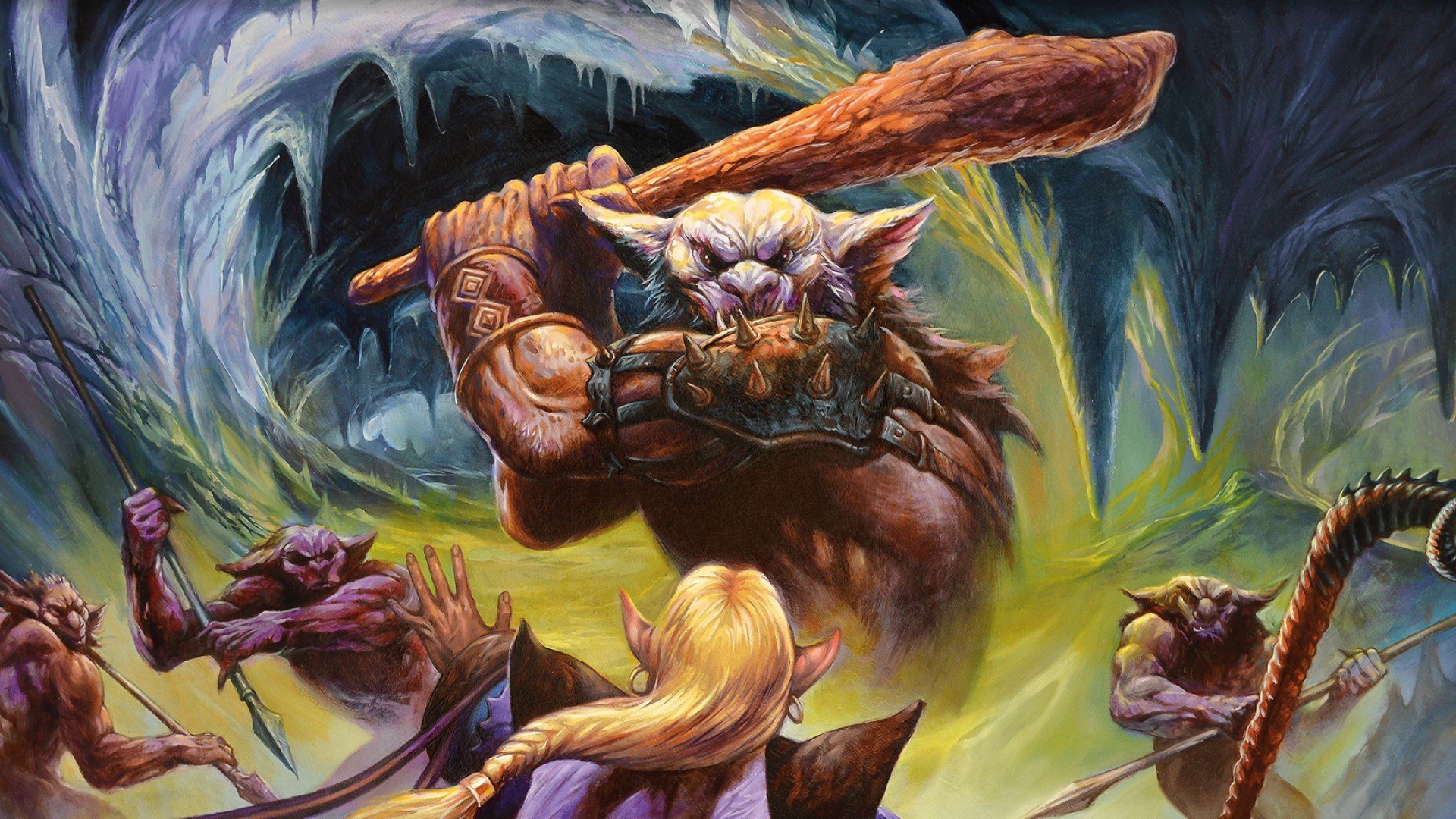Languages dnd – Languages in Dungeons & Dragons (DnD) are a crucial element that enhances communication, enriches roleplaying, and deepens the immersive experience for players. This guide delves into the diverse range of languages featured in DnD, providing insights into their significance and offering practical tips for creating and using languages in roleplaying scenarios.
From common tongues to rare and exotic dialects, DnD languages serve various purposes, enabling characters to interact, form alliances, and unravel ancient secrets. Understanding the nuances of each language adds depth to characterization and opens up new possibilities for storytelling.
Languages in Dungeons & Dragons
Languages are a crucial aspect of Dungeons & Dragons, enriching communication and roleplaying experiences. The game features a diverse array of languages, each with its own significance and usage.
Types of Languages
Languages in Dungeons & Dragons are categorized into three primary types:
- Common:Widely spoken and understood by most characters, including humans, dwarves, elves, and halflings. It is the default language for communication in most settings.
- Uncommon:Known by a smaller group of individuals, such as gnomes, half-orcs, and tieflings. Uncommon languages are often associated with specific cultures or professions.
- Rare:Spoken by a limited number of characters, such as dragons, mind flayers, and beholders. Rare languages are typically ancient, secret, or used by powerful entities.
Significance of Languages, Languages dnd
Languages play a significant role in Dungeons & Dragons, influencing gameplay and character development:
- Communication:Languages facilitate communication between characters of different backgrounds and races. Understanding multiple languages allows characters to interact with a wider range of NPCs and gain valuable information.
- Roleplaying:Languages add depth to roleplaying by enabling characters to speak in their native tongues or learn new languages to connect with different cultures.
- Lore and Worldbuilding:Languages reflect the history and diversity of the game world. Learning a new language can reveal insights into different cultures, factions, and ancient civilizations.
Creating Custom Languages

Custom languages are a great way to add depth and flavor to your Dungeons & Dragons campaign. They can be used to create secret societies, ancient civilizations, or even entire worlds. Creating a custom language is not as difficult as you might think, and it can be a lot of fun.
The first step in creating a custom language is to decide what kind of language you want to create. Do you want a spoken language, a written language, or both? What kind of culture is the language from? What level of complexity do you want the language to have?
Once you have a good idea of what kind of language you want to create, you can start to develop the grammar and vocabulary. The grammar of a language is the set of rules that govern how words are combined to form sentences.
The vocabulary of a language is the set of words that are used to express ideas.
When developing the grammar of your language, you need to decide what kind of sentence structure you want to use. Do you want a subject-verb-object sentence structure, or a verb-subject-object sentence structure? What kind of tenses and moods do you want to use? How do you want to handle negation and questions?
When developing the vocabulary of your language, you need to decide what kind of words you want to include. Do you want to include words for everyday objects, or do you want to include more specialized words? Do you want to include words for abstract concepts, or do you want to focus on concrete words?
Once you have developed the grammar and vocabulary of your language, you need to decide how you want to pronounce the words. Do you want to use a phonetic alphabet, or do you want to create your own pronunciation system? How do you want to handle stress and intonation?
Creating a custom language can be a lot of work, but it can also be a lot of fun. If you are interested in creating a custom language for your Dungeons & Dragons campaign, there are a number of resources available to help you get started.
Examples of Custom Languages
There are many examples of custom languages that have been created for Dungeons & Dragons. Some of the most popular custom languages include:
- Dwarvish: Dwarvish is a spoken and written language that is used by dwarves. It is a guttural language that is full of consonants. Dwarvish is a very old language, and it has a rich history.
- Elvish: Elvish is a spoken and written language that is used by elves. It is a beautiful and lyrical language that is full of vowels. Elvish is a very old language, and it has a rich history.
- Gnomish: Gnomish is a spoken and written language that is used by gnomes. It is a playful and whimsical language that is full of puns and riddles. Gnomish is a relatively young language, but it has quickly become one of the most popular custom languages for Dungeons & Dragons.
These are just a few examples of the many custom languages that have been created for Dungeons & Dragons. If you are interested in creating a custom language for your campaign, there are a number of resources available to help you get started.
Using Languages in Roleplaying

Incorporating languages into roleplaying significantly enhances immersion and realism, allowing players to fully embody their characters and interact with the world in a more authentic manner. Mastering the art of language use in roleplaying can create memorable characters, foster engaging interactions, and elevate the overall gaming experience.
Creating Memorable Characters
Languages play a pivotal role in shaping character identities. Assigning specific languages to characters based on their background, culture, and experiences adds depth and authenticity to their personas. Consider the following tips:
- Research real-world languages and cultures that align with the character’s background to draw inspiration for their speech patterns, accents, and vocabulary.
- Develop a unique vocabulary and mannerisms for each character’s language, reflecting their personality, motivations, and social status.
li>Incorporate non-verbal cues, such as gestures, facial expressions, and body language, to enhance the character’s language use and make them more expressive.
Engaging Interactions
Languages facilitate immersive interactions between characters, fostering a sense of authenticity and connection. By using different languages, players can create dynamic and realistic conversations, negotiate with NPCs, and build relationships based on shared linguistic abilities. Consider the following techniques:
- Use languages to create barriers and challenges in communication, requiring players to find creative ways to overcome language barriers.
- Introduce characters who speak multiple languages, allowing for seamless communication and fostering a sense of cultural diversity.
- Incorporate puzzles or riddles that require players to decipher ancient languages or decode secret messages, adding an element of mystery and intrigue.
Examples of Effective Language Use
Numerous roleplaying sessions have showcased the transformative power of languages in enhancing gameplay. Consider the following examples:
- In a fantasy setting, a group of adventurers encountered a hidden village where the inhabitants spoke an ancient and forgotten language. Learning the language allowed the players to uncover the village’s secrets and forge an alliance with its people.
- In a science fiction campaign, players encountered a species with a complex and nuanced communication system. By mastering their language, the players gained insights into their culture and were able to negotiate a peaceful resolution to a conflict.
- In a historical roleplaying game, players took on the roles of diplomats tasked with negotiating a treaty between two warring nations. Using their knowledge of multiple languages, they were able to bridge cultural divides and broker a successful agreement.
Translating Languages: Languages Dnd

Translating languages in Dungeons & Dragons presents unique challenges due to the fictional nature of the languages and the need for consistency within the game world. However, with careful planning and the use of available resources, DMs and players can effectively translate languages to enhance their roleplaying experience.
Challenges of Translating Languages
- Lack of Native Speakers:Fictional languages in D&D do not have native speakers, making it difficult to determine the exact meaning and pronunciation of words.
- Cultural Differences:Languages are shaped by the cultures that use them, so translating between languages with vastly different cultures can be challenging.
- Limited Resources:Official resources for translating languages in D&D are often limited, requiring DMs and players to create their own dictionaries and grammar rules.
Techniques for Translating Languages
Despite these challenges, there are several techniques that can help DMs and players translate languages effectively:
- Use Context:The context in which a word or phrase is used can provide valuable clues about its meaning.
- Create a Dictionary:Compile a list of words and phrases in both the original and translated languages to aid in future translations.
- Consult Online Resources:Websites like the Forgotten Realms Wiki and the D&D Beyond Language Creator offer dictionaries and other resources for translating languages.
- Involve Players:Players can contribute to the translation process by researching the cultures and languages of their characters.
Tips for Accurate Translations
- Stay Consistent:Establish a consistent translation method and stick to it throughout the campaign.
- Consider the Culture:Take into account the cultural context of the language to ensure that the translation is appropriate.
- Test the Translation:Have native speakers or other players review the translation to ensure its accuracy.
Last Recap
In conclusion, languages in DnD are a powerful tool that empowers players to create memorable characters, engage in immersive roleplaying, and navigate the intricate world of DnD with greater depth and authenticity. By embracing the diversity of languages and incorporating them into gameplay, players can enhance their storytelling experiences and create truly unforgettable adventures.
FAQs
What is the most common language in DnD?
Common is the most widely spoken language in DnD, used by most humanoids and many other creatures.
Can I create my own languages for DnD?
Yes, the Dungeon Master’s Guide provides guidelines for creating custom languages, including grammar, vocabulary, and pronunciation.
How do languages impact roleplaying?
Using languages in roleplaying enhances immersion, allows for secret communication, and adds depth to character interactions.